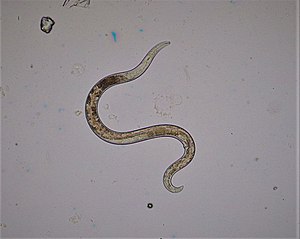
Nematodes, commonly known as roundworms, are one of the commonest groups of animals, found in most land, freshwater, and marine environments. Of over 80,000 known species, about 15,000 are parasitic. Nematodes are classified as members of the phylum Nematoda.
Various types of free-living (non-parasitic) nematodes feed on algae, fungi, small animals, fecal matter, and carrion. Nematodes are an important component of the decomposition system. Some species are considered to be crop pests, while others are predators of crop pests.
Parasitic nematodes exhibit a great variety of lifestyles, and depending on species may infest humans, animal species, or may move from one to the other.
Some nematodes parasitic on humans include:
- Ascaris lumbricoides, which lives in the respiratory and digestive systems and causes the widespread disease ascariasis
- filarids
- hookworms
- pinworms
- whipworms
Others:
- Baylisascaris
- Haemonchus contortus, commonly infests sheep worldwide.
- Trichinella spiralis (trichina worm), cause of trichinosis; infests humans, pigs, and rats.